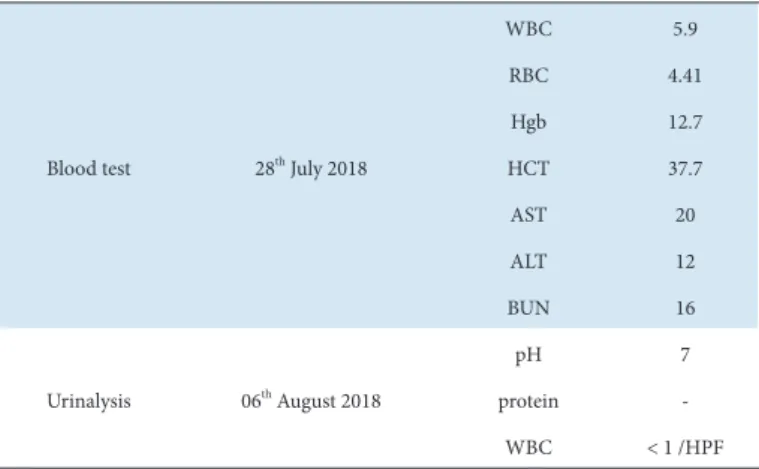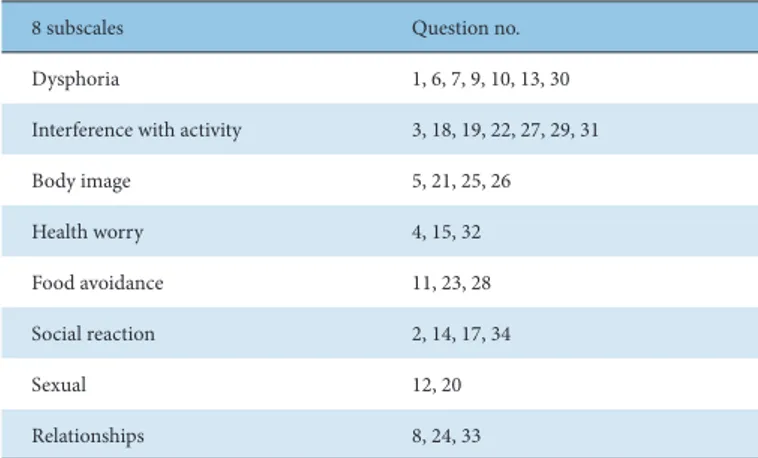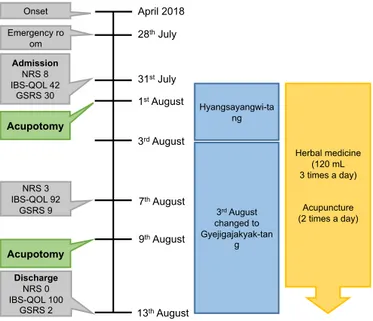The effects of complex Korean medicine treatment including acupotomy, on irritable bowel syndrome (IBS) are reported in this case study. A 54-year-old woman with diarrheal symptoms that alternatively improved and worsened for many years and worsening abdominal pain visited the emergency room and was diagnosed with IBS; she was admitted for approximately 2 weeks at the Acupuncture and Moxibustion Department of National Medical Center (NMC). Numerical rating scale (NRS), irritable bowel syndrome–quality of life (IBS-QOL), and gastrointestinal symptom rating scale (GSRS) scores were evaluated on the day of hospitalization, midway through the hospitalization period, and on the day of discharge. Abdominal pain was measured daily using NRS, and the score decreased from 8 at admission to 0 at discharge. The IBS-QOL percentile score improved from 42 points to 100 points. The total GSRS score also improved, from 30 points to 2 points. These results suggest that complex Korean medicine treatment with acupotomy, is useful for treating internal diseases, such as IBS, as well as musculoskeletal disorders.
©2020 Korean Acupuncture & Moxibustion Medicine Society. This is an open access article under the CC BY- NC-ND license (http://creativecommons.org/licenses/by-nc-nd/4.0/).
Article history:
Submitted: October 24, 2019 Revised: November 4, 2019 Accepted: January 31, 2020 Keywords:
irritable bowel syndrome,
acupotomy, miniscalpel acupuncture, Back-Shu Point, Korean medical treatment, case report
https://doi.org/10.13045/jar.2019.00311 pISSN 2586-288X eISSN 2586-2898
Case Report
The Effect of Complex Korean Medical Treatment with Acupotomy on Irritable Bowel Syndrome: A Case Report
Baek Ki Min
1, Joon Soo Jin
2, Do Eun Lee
3, Won Bin Shin
4, Jin Hyeon Shin
5, In Ae Youn
1,*
1 Department of Acupuncture and Moxibustion Medicine, National Medical Center, Seoul, Korea 2 Department of Internal Medicine of Korean Medicine, National Medical Center, Seoul, Korea 3 Department of Oriental Neuropsychiatry, National Medical Center, Seoul, Korea
4 Department of Acupuncture and Moxibustion Medicine, Bucheon Jaseng Hospital of Korean Medicine, Bucheon, Korea 5 Department of Acupuncture and Moxibustion Medicine, Korean Medicine Hospital of Woosuk University, Jeonju, Korea
ABSTRACT
Journal of Acupuncture Research
Journal homepage: http://www.e-jar.org
Introduction
Irritable bowel syndrome (IBS) is a functional disorder of the digestive system characterized by abdominal pain, changes in the consistency of feces, or changes in bowel habits that are not caused by substrate ingestion [1]. The prevalence rate of IBS in the Korean population ranges from 9%-9.6% [2,3]. Repeated abdominal pain and bowel movements lead to a loss in quality of life (QOL), and an increase in economic burden due to the high medicinal costs associated with treatment through repeated improvement and deterioration; thus, it is necessary to improve patients’ QOL through active treatment [4,5]. Some medical research in Korea has been conducted on IBS treatment using general acupuncture, moxibustion, cupping, phamarcoacupuncture, and herbal medicine. However, there has been no reports on the use of acupotomy in the treatment of digestive system conditions/diseases
including IBS [6].
Acupotomy therapy is a treatment that exfoliates adhesions, releases muscle, harmonizes yin and yang, and expands the microcirculatory system to help recover local lesions [7]. Treatment of Back-Shu points can relieve spinal muscle tension, relieve pressure on the nerve roots, inhibit hyperstimulation of intestinal signals, and control the synthesis and release of neurotransmitters [8]. Here, we report a case IBS treated with a combination of Korean medical treatment and acupotomy in Back-Shu points that improved the symptoms of IBS.
Case Report Patient
The patient is a 54-year-old woman, without a specific occupation.
*
Corresponding author. In Ae YounDepartment of Acupuncture and Moxibustion Medicine, National Medical Center, Seoul, Korea E-mail: eknowkey@nmc.or.kr
ORCID: Baek Ki Min https://orcid.org/0000-0003-2331-2536, In Ae Youn https://orcid.org/0000-0002-1463-2178
©2020 Korean Acupuncture & Moxibustion Medicine Society. This is an open access article under the CC BY-NC-ND license (http://creativecommons.org/licenses/by-nc- nd/4.0/).
Chief complaint and onset
The patient complained of diarrheal symptoms that showed alternating improvement and worsening for many years beginning in early April 2018 and worsening abdominal pain in late July 2018.
Past history Nonspecific.
Present illness
The patient visited the emergency room of our health center on July 28
th2018, with the above-mentioned symptoms. Blood tests and urinalysis results were within normal limits (Table 1), and X-ray findings were not unusual (Figs. 1 and 2). IV therapy and PO medications were prescribed and administered without improvement. On July 30
th, she refused an endoscopy during an outpatient visit to the Digestive Medicine Department of National Medical Center (NMC), and she was admitted to the Acupuncture and Moxibustion Department on July 31
st.
Diagnosis
The patient complained of tenderness in the entire abdominal area, and stated that she had diarrhea >5more than five times a day with an improvement in the symptoms after bowel movements. She complained that she suffered from loose bowel movements with pain of approximately 10 numerical rating scale
(NRS) before defecating (this reduced to 8 NRS when she did not defecate) and had a dull stomachache for approximately 3 months. The patient was diagnosed with IBS using the Rome IV diagnostic criteria (Table 2), and local guidelines that allowed dietary control, nonpharmaceuticals, and medication of up to 4 weeks without performing colon endoscopy when there were no specific symptoms in the blood test and no warning signs, such as melanorrhagia, and weight loss with unknown cause [1,9].
Patient protection policy on patient information use
To protect the patient’s information and rights, approval was sought from and granted by the Institutional Review Board of National Medical Center before conducting the study (IRB no.:
H-1908-105-001).
Fig. 1. Abdomen erect view.
Fig. 1. Abdomen erect view.
Fig. 2. KUB view.
Fig. 2. KUB view.
Table 1. Clinical Chemistry Analysis Results.
Blood test 28th July 2018
WBC 5.9
RBC 4.41
Hgb 12.7
HCT 37.7
AST 20
ALT 12
BUN 16
Urinalysis 06th August 2018
pH 7
protein -
WBC < 1 /HPF
ALT, alanine aminotransferase; AST, aspartate aminotransferase; BUN, blood urea nitrogen; HCT, hematocrit; Hgb, hemoglobin; RBC, red blood cell; WBC, white blood cell.
Repeated abdominal pain at least 1 day per week in the last 3 months is associated with ≥ 2 of the following criteria:
Related to defecation
Relating to changes in the frequency of feces Relating to changes in the form of feces (shape)
The criteria have been met for ≥ 6 months before the diagnosis in the past 3 months when the symptoms started IBS, irritable bowel syndrome.
Table 2. IBS of Rome IV Diagnostic Criteria.
Treatment Acupotomy
Before acupotomy treatment, the patient provided written informed consent. Treatment was performed 2 times for 2 weeks (1
stand 9
thAugust). The practitioner wore a disposable mask and sterile latex gloves. Acupotomy was performed by a medical doctor with >2 years of clinical experience. Using the DongBang Acupotomy (DongBang Corp., 0.5 × 50 mm, disposable, sterile stainless steel), bilateral BL20, BL21, BL22, and BL25 were palpated, and the procedure was applied to the induration and tenderness points around the surrounding area. Acupotomy needles were directly at a depth of 20-40 mm parallel to the nerves and blood vessels to confirm the incision of the induration and pulled out.
Hemorrhagic bands were attached after inserting the needle, and the patient was educated on the prevention of contamination as well as the possible symptoms, such as pain, blood pressure drop, bleeding, and dizziness, that occur after treatment. This acupotomy treatment procedure was written to the Standard for Reporting Interventions in Clinical Trials of Acupuncture (STRICTA).
Acupuncture treatment
Acupuncture was performed twice daily (in the morning and afternoon). Using the Dongbanchim (DongBang Corp., 0.20 × 30 mm, disposable, sterile stainless steel), CV12, both sides of LI04, LR03, LI11, ST36, and SP04 were inserted and left for 15 min.
Herbal medicine
The patient was prescribed Hyangsayangwi-tang and Gyejigajakyak-tang. From the evening of August 3, it was changed to Gyejigajakyak-tang. Then, 120cc was taken thrice a day after meals (Table 3).
Evaluation methods
NRS For the pain assessment, the degree of abdominal pain was evaluated using NRS and recorded as a date for a change in NRS.
The lower the subjectivity of the pain felt by the patient, the closer it is to zero and the greater the probability of the patient to choose a number close to 10.
Irritable bowel syndrome–quality of life (IBS-QOL)
IBS-QOL is a questionnaire consisting of 34 categories that evaluate the QOL loss caused by IBS. It evaluates the degree of QOL by statements that describe respondents’ feelings on a five- point recertification scale (1 = not at all; 2 = slight; 3 = moderate;
4 = very little; 5 = extremely or a great deal). The eight subscales (Table 4) and total score are converted to percentiles of 0 (indicating lack of QOL) to 100 (indicating the maximum QOL) using the following formula, and all items are overturned so that the higher the IBS-QOL score, the better the QOL [10]. The patient completed the questionnaire at the time of hospitalization, midway through the hospitalization period, and at discharge.
Score = {(The sum of the items–Lowest possible score)/Possible raw range} × 100
Gastrointestinal symptom rating scale (GSRS)
GSRS is a questionnaire used to determine gastrointestinal symptoms in hypersensitivity colorectal syndrome and digestive ulcer disease, and it comprises 15 categories. The patient completed the questionnaire at the time of hospitalization, midway through the hospitalization period, and at discharge [11].
Evaluation result
Abdominal pain was measured daily using NRS, and it decreased from 8 at admission to 0 at discharge. The IBS-QOL subscale percentiles are Dysphoria (34 → 90), Interference with Activity (25 → 93), Body Image (19 → 100), Health Worry (42 → 100), Food Avoidance (25 → 83), Social Reaction (86 → 100), Sexual (25 → 100), and Relationships (42 → 100). The IBS-QOL percentile score improved from 42 points to 100 points. The total GSRS score also improved from 30 points to 2 points (Table 5; Fig. 3).
Discussion
IBS is the most common functional intestinal disease that is unaccompanied by any substrate abnormality and shows changes in abdominal pain and bowels. Pathogenesis is thought to arise from visceral hypersensitivity, brain–gut interaction, postinfectious primary bowel syndrome, and genetic factors. However, the true
Table 3. Composition of Herbal Medicine.
Prescription Composition (g)
Hyangsayangwi-tang
Panax ginseng C. A. Meyer 6 Atractylodes macrocephala Koidzumi 6 Paeonia lactiflora Pallas 6
Glycyrrhiza uralensis Fischer 6 Pinellia ternata (Thunb.) Breitenbach 6 Cyperus rotundus L 6
Citrus unshiu Markovich 6 Zingiber officinale Roscoe 6 Crataegus pinnatifida Bunge 6 Amomum villosum Lour 6 Amomum cadamomum L 6 Zingiber officinale Roscoe 6 Zizyphus jujuba var. inermis Rehder 6
Gyejigajakyak-tang
Cinnamomum cassia Blume 6 Zizyphus jujuba var. inermis Rehder 8 Zingiber officinale Roscoe 6 Glycyrrhiza uralensis Fischer 4 Paeonia lactiflora Pallas 24
8 subscales Question no.
Dysphoria 1, 6, 7, 9, 10, 13, 30
Interference with activity 3, 18, 19, 22, 27, 29, 31
Body image 5, 21, 25, 26
Health worry 4, 15, 32
Food avoidance 11, 23, 28
Social reaction 2, 14, 17, 34
Sexual 12, 20
Relationships 8, 24, 33
IBS-QOL, irritable bowel syndrome–quality of life.
Table 4. Eight Subscales of IBS-QOL.
cause or pathogenesis of the disease remains unknown [1,12].
Previously, intestinal inflammation was perceived as an organic abnormality, but this is no longer understood to be the case unless the inflammation is severe. Recent studies have found that low- grade intestinal inflammation is important in the pathophysiology of intestinal diseases. Therefore, research is underway to locate the biomarkers of IBS [13]. However, due to the absence of a clear biomarker, the diagnosis is based on the Manning and ROME criteria [12]. According to the 4
thedition of the revised ROME standard in 2016, symptoms that began 6 months ago should include repeated abdominal pain for ≥1 day/week for ≥1 week in the last 3 months and are classified as IBS when abdominal pain is associated with defecation, stool frequency, and stool appearance. IBS is diagnosed and classified into 4 subtypes, namely constipation, diarrhea, mixed, and nonspecific [13]. IBS treatment includes psychiatric treatments, such as dietary control, medication for symptoms, and cognitive behavioral therapy, if necessary. The dietary regulation stems from the fermentation of a low-molecular carbohydrate, namely, FODMAP, in the intestines, which aggravates symptoms in patients with IBS. Low FODMAPs Diet is found to be generally effective. However, it is difficult to use Low FODMAP Diet actively as it is not necessary to label ingredients in food in Korea and further research on
long-term research, diet composition, and recipes is needed in the future [14]. Drug treatment is based on the subtypes, namely, constipation, diarrhea, mixed, and nonspecific; depending on the symptoms, treatment is applied accordingly. Constipation type drugs include laxatives, serotonin type 4 receptor agonists, and selective chloride channel activator; for diarrhea type, antidiarrheal drugs and serotonin type 3 receptor antagonists are used. Moreover, to relieve abdominal pain, antispasmodics, and antidepressants, are prescribed. However, this symptomatic drug use in IBS treatment may exacerbate other symptoms, especially where symptoms of constipation and diarrhea coexist [9]. From a brain–gut interaction perspective, afferent nerves send signals to the central nervous system, and centrifugal signal transduction can cause changes in intestinal motility and intestinal immunity, leading to a variety of gastrointestinal disorders [12]. The Back- Shu point is an acupuncture point located on both sides of the spine that can be used to diagnose the organ state in the case of changes in the area [15]. It is closely located to the lateral ganglion in the lower and upper thoracic vertebrae [8]. In the sympathetic visceral motor innervation, neurons from T10–T12 dominate the small intestine and ascending colon, whereas neurons from L1- L2 dominate the descending colon, sigmoid colon, rectum, and corresponding visceral vessels [16]. Back-Shu point treatment is based on this sympathetic nervous system innervation, which flows backward from the thoracic lumbar spine [17]. Therefore, it can be used in the treatment of IBS, a digestive disorder, by checking the convulsions or tenderness of BL20 (T11 Level), BL21 (T12 Level), BL22 (L1 Level), and BL25 (L4 Level), as shown in this study. Acupotomy therapy is effective for treating neurological ataxia caused by soft tissue injuries and may be more effective than conventional acupuncture in tissue restoration [18].
The acupotomy theory in China explains that soft tissue lesions can cause internal pressure due to mechanical compression of the lesion tissue around the spinal canal and accumulation of inflammatory exudates, which can compress the visceral nerves.
This pressure can be removed by acupotomy treatment to restore microcirculation at the lesion site and improve organ malfunction [18,19]. The patient has had chronic digestive discomfort for a very long time and complained of abdominal pain with a high NRS score but, the patient refused to consult a gastroenterologist and wanted a quick effect with Korean medicine treatment. If there is problem with a particular organ, an adverse reaction may occur at the corresponding Back-Shu point. Thus, the Back-Shu point can be both a diagnostic point and a treatment point [9,16]. The patient complained of severe tenderness at the Back-Shu point, and this tenderness and hypersensitivity could be seen as the action of nociceptive neurons by inflammatory mediators [9]. In this chronic and severely painful condition, the internal pressure can
2018
Date 31st July
(admission) 1st August 2nd August 3rd August 7th August 10th August 13th August 2018 (discharge)
NRS 8 6 4 5 3 0 0
IBS-QOL 36.76 - - - 75 - 94.85
GSRS 30 - - - 9 - 2
GSRS, gastrointestinal symptom rating scale; IBS-QOL, irritable bowel syndrome–quality of life; NRS, numerical rating scale.
Table 5. Changes in NRS, IBS-QOL, and GSRS scores.
Fig. 3. Timeline of treatments and outcomes.
Hyangsayangwi-ta ng
3rd August changed to Gyejigajakyak-tan
g
Herbal medicine (120 mL 3 times a day)
Acupuncture (2 times a day) Emergency ro
om
31st July April 2018 Onset
28th July Admission
NRS 8 IBS-QOL 42
GSRS 30
3rd August
NRS 3 IBS-QOL 92
GSRS 9
Discharge NRS 0 IBS-QOL 100
GSRS 2 13th August
7th August 1st August
9th August Acupotomy
Acupotomy
Fig. 3. Timeline of treatments and outcomes.


